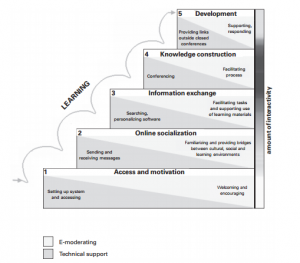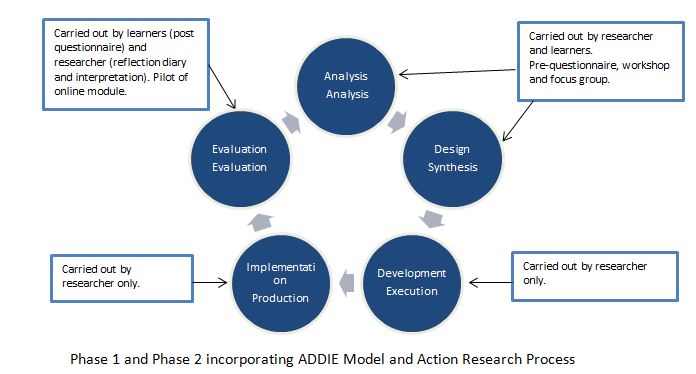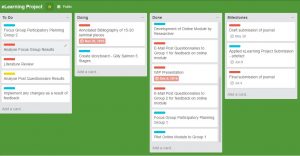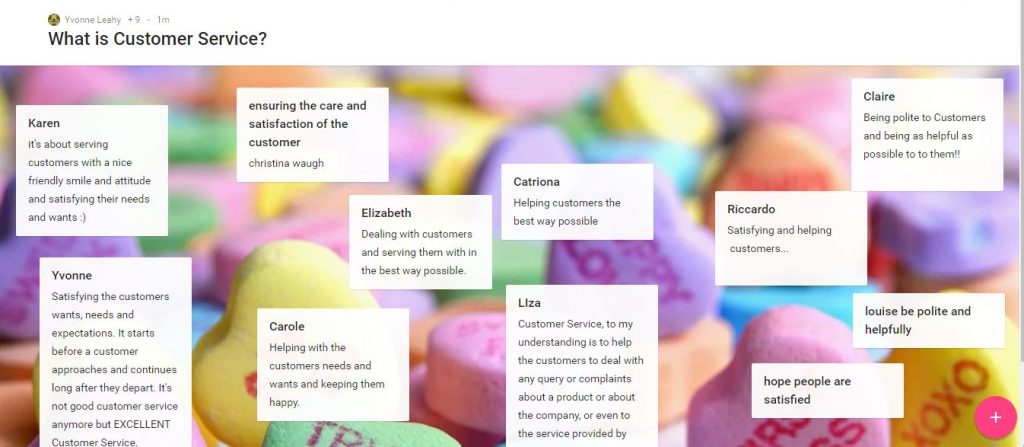
During the MSc in Applied eLearning I have travelled on a journey of self-discovery with the acquisition of new skills and knowledge. Furthermore, due to the practical element of the programme it afforded me the opportunities to implement many of these new skills into my own practice. The following will discuss each of the modules (some combined) incorporating how I have demonstrated the learning outcomes of the programme into my own practice.
Learning Theories
The Learning Theories module introduced me to eLearning theories which I applied to my own professional practice. As I work with adult learners in the further education sector I found that behaviourism, whilst beneficial at times (Merriam & Bierema, 2013), used alone was not conducive. The Learning Theories module reintroduced me to constructivism and other new theories including connectivism. Constructivism demonstrates “new knowledge is adapted rather than adopted” (Jordan, Carlile & Stack, 2008, p.56). I found this active process where learners construct their own knowledge through experience and reflection to be very positive in my practice.
Furthermore, andragogy is very relevant to my own practice and this was also the primary theory associated with my own research. I also realised that social constructivism is appropriate for eLearning and has been useful in the blended learning environment I have introduced into my own classroom. Using CourseSites it enables discussion and peer learning through collaboration, forums and sharing information. While some learners have been slow to adapt (Salmon, 2006) I have observed adult learners becoming more at ease with technology as a result.
Trends in eLearning
The Horizon Report speculates the current technologies/trends in Higher Education. This along with the Trends in eLearning module provided me with an awareness and understanding of current eLearning technologies. By implementing these into my own practice I also realised the challenges and opportunities they can present. For example, for my presentation on Flipped classrooms I tested this with my class. Learners found the aspect of being able to watch the video repeatedly beneficial in order to enhance the learning. I also found that learners came to class with a good understanding allowing for in-depth discussions. However, the challenge it may present is the amount of time in preparing the material. On the other hand, once created it can be re-used. Mobile learning and bring your own devices would also be very effective in my practice. Many learners have voiced how they would like to be able to use their own devices. However, the challenges presented would be the fact that not all learners in the class may have their own devices. It may be worthwhile looking at having some devices in centres for these learners to use.
Furthermore, trends in technology are always evolving but I believe it is vital to keep up to date so that we have to tools to enhance the learning and communicate with our learners. As a result I have used Twitter as a means to keep up to date with trends and the Top 100 eLearning Tools from Jane Hart.
Instructional Design and eAuthoring
The Instructional Design and eAuthoring module was the foundation for my research project. As a group project it enabled peer learning and the opportunity to be involved in the design of a project in preparation for our individual research project in Year 2. I had the opportunity to do storyboarding and use software such as Articulate which I have reviewed in the my Tech Reviews.
When designing both the Instructional design and research project ensuring that both eLearning courses were grounded in theory was fundamental. This was achieved in a number of ways. Using Chickering and Gamson ensured that the principles of teaching were applied. Furthermore, the principles of Chickering and Gamson are considered as an acceptable “rubric for evaluating online course design and online instruction (Tirrell and Quick, 2012, p.588). The following illustrates its implementation:
ChickeringTo promote constructivism and scaffolding Gilly Salmon’s Five Stage Model was also incorporated. This model provides a framework for creating conditions to support the learner to become more self-directed (Dias, Diniz, & Hadjileontiadis, 2014).

Figure 2 Five Stage Model (Salmon, 2013, p.11)
On reflection, this is something that I now implement into my own practice when designing a course. Andragogy plays a major role as I work in the adult education sector and as a result of this course I am now looking at heutagogy. This refers to self-determined learning which goes beyond the acquisition of skills and knowledge and focuses on the learners capabilities. It also acknowledges the importance of involving the learner in designing their learning (Hase & Kenyon, 2001).
Instructional Design and Research Project
Managing the design, development, implementation and evaluation of a number of appropriate eLearning resources was demonstrated in both the Instructional Design group project and my own Research Project. In managing the design, development, implementation and evaluation of the eLearning resources I implemented the ADDIE model for Phase 1 and Phase 2 of the project. Each step feeds into the following step and is an iterative process.

I also used Trello as a project management tool which is a very easy to use web based management tool. I particularly liked the drag and drop approach. The following is an illustration taken during the project.

Trello
On reflection, in order to manage the process it is important to have an instructional design model in place. In the future I may look at others that I discussed in my reflections during the Instructional Design module.
Research Project
The research project enabled me to identify instances and conditions where eLearning would be appropriate. Converting the Career Planning module to online was appropriate as it has the potential to afford learners in remote areas the opportunity to participate in the course. It promotes lifelong learning and online learning today “can widen participation in lifelong learning” promoting opportunities for all citizens (DfES, 2003, p.7).
Other areas identified and evaluated in my own practice was the implementation of online collaboration using Padlet, CourseSites and Socrative for assessment purposes. The following is a padlet created with one of my classes:

As many of our courses are part time where learners may only have 3 hour classes once or twice a week it is important to have conditions in place so that learners have a platform to access information to reinforce the learning. This was piloted with an Office Skills class and they found the use of learning management systems to promote a blended learning approach and social constructivism very positive. On reflection, I believe that eLearning is appropriate in many circumstances albeit a fully online course, classroom or blended. Furthermore, technology is not there to replace the teaching but to enhance it.
The Research Project allowed me to design a constructively aligned module. As part of the research adult learners were involved in the redesign of a career planning module to ensure that their voice was heard and to ascertain if their involvement would increase their participation in online learning and self-directedness. This has been discussed in the research proposal. This was due to the low number of adult learners completing courses in the further education sector.
The research project also gave opportunities for eLearning applications/resources to be designed and evaluated determining their value. The analysis and design was carried out by myself and participants, a form of co-curriculum design. This was very beneficial as it was invaluable to get feedback from learners who normally just complete evaluation forms at the end of a course (Bovill and Bulley, 2011). The research project was evaluated by the learners as part of the ADDIE process. During the course I created resources using a range of different eLearning technologies and evaluated them to determine their value to my own practice. This is outlined in the Tech Reviews section of the ePortfolio. On reflection, this broadened my knowledge on the tools and resources available and this is something I plan to continue after the MSc. Creating the ebooks and simulation and presentation using Video Scribe allowed me to incorporate these technologies into my own practice. For example I have used the ebooks I created on interview questions for current learners and they have found it very beneficial.
Sustaining evidence and reasoned arguments with conclusions was demonstrated on the completion of the eLearning project and exists in the completed journal. Throughout the journal arguments were drawn using existing literature and conclusions were made. The research project enabled me to engage in research and to evaluate the online Career Planning module in my own practice. The eLearning resources used included iSpring Suite, www.teachable.com and iSpring Cloud. This was conducted by carrying out action research and the triangulation of data gathered from pre and post questionnaires, focus group discussions and the creation of a journal. This allowed me to answer the research question. The results indicated that
During the course I created and evaluated strategies for the effective use of eLearning in my own practice. This is evident in the Tech Reviews which I carried out throughout the MSc. It enabled me to not only review these eLearning tools but to create appropriate resources for my own practice.
Educational Research Design and Research Project
I conducted critically focused literature reviews for my research project and in the proposal for the project. The Educational Research Design project enabled me to focus on literature and immerse myself in the area for my project. A literature review is not a description of the literature but an assessment of its significance from a critical stance. As a result, the literature reviews have given me a more comprehensive insight into adult education and eLearning while guiding my research project based on the concepts and theories that evolved from my readings. The following are links to my literature reviews.
Furthermore, the creation of this ePortfolio provided a platform to reflection self-critically on the process and outcomes of a development and eLearning implementation project. A monthly reflection was completed to capture reflections and the Year 2 Project Reflection outlines the limitations and lessons learned on the project.
Despite the completion of the MSc I will still continue my journey by building on the skills I have learned over the past two years. I aim to achieve this by keeping up to date with developments in both theoretical and practical elements of education and technology.
References:
Bovill, C. and Bulley, C.J. (2011) A model of active student participation in curriculum design: exploring desirability and possibility. In Rust, C. Improving Student Learning (18) Global theories and local practices: institutional, disciplinary and cultural variations. Oxford: The Oxford Centre for Staff and Educational Development, pp176-188.
DfES (2003). Towards a unified eLearning strategy. Retrieved June 10, 2016, from: https://www.education.gov.uk/consultations/downloadableDocs/towards%20a%20unified%20e-learning%20strategy.pdf.
Hase, S., & Kenyon, C. (2001). Moving from andragogy to heutagogy: implications for VET. Graduate College of Management Papers, 142.
Jordan, A., Carlile, O., & Stack, A. (2008). Approaches to Learning . Maidenhead: Open University Press.
Merriam, S. B., & Bierema, L. L. (2013). Adult learning: Linking theory and practice. San Francisco: John Wiley & Sons.
Salmon, G. (2006). Emoderating: The key to teaching and learning online (2nd ed). Abingdon, Oxon: Routledge.
Tirrell, T., & Quick, D. (2012). Chickering’s seven principles of good practice: Student attrition in community college online courses. Community College Journal of Research and Practice, 36(8), 580-590.